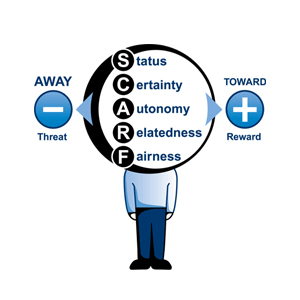SCARF
 Leadership and learning to be a leader is all about people management, social relationships with people, and about the rewards and threats that, by their behavior, managers send signals to their people. The SCARF model contains a summary of the discoveries in neuroscience about how people interact and how they encounter.
Leadership and learning to be a leader is all about people management, social relationships with people, and about the rewards and threats that, by their behavior, managers send signals to their people. The SCARF model contains a summary of the discoveries in neuroscience about how people interact and how they encounter.
Status, Certainty, Autonomy, Relatedness and Fairness create five domains - elements that leaders and managers need to know and exhibit in their behavior. All of these domains have their direct ‘representation’ in the brain.
The SCARF model contains a summary of the discoveries in neuroscience about how people interact and how they encounter. One of the basic - and important discoveries for us - is that the brain treats many social (psychological) rewards and threats with the same intensity as material/physical rewards and threats.
 1. Status
1. Status
This concerns the relative importance of a person towards other people in the organization or training process. In our programs we are relating to participants as equally important.
2. Certainty
It is the possibility and ability to foresee the future. In our case it is the ability to predict the course of the training or workshop, meaning its transparency.
3. Autonomy
Sense of control over events. Participants in the programs clearly perceive that they can make decisions and decide on the next steps of the program.
4. Relatedness
Feel safe in the relationship with others. We show people that we accept and respect their way of being although it does not mean that we agree with all their views.
5. Fairness
People feel that they are treated fairly.
It is clear now that these domains strongly influence the quality of leadership and also the quality of training programs and workshops. Leadership and learning to be a leader is all about people management, interpersonal relationships, and how, by their behaviour, managers signal to their people rewards and threats. The perceived threat to their position by the leader activates the same brain networks as a threat to life. Increased and perceived fairness activates the same brain ‘rewarding’ circuits such as obtaining financial rewards.


